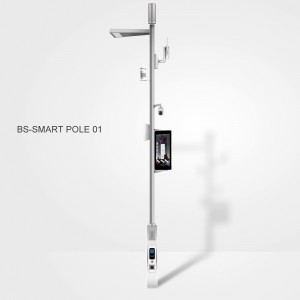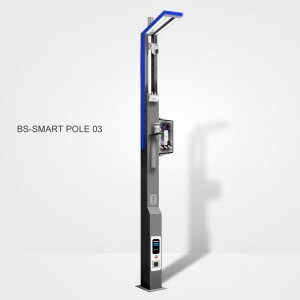Initial inputs and return on investment
The initial capital for a smart pole project can vary widely, depending on the features included, such as IoT connectivity, surveillance, lighting, environmental sensors, and charging stations. Additional costs include installation, infrastructure and maintenance. Let’s take a look at our flagship product – the modularity Smart Pole 15, which offers the most flexibility in equipment selection. ROI depends on energy savings, efficiency gains, and the potential for revenue generation, such as advertising on LED displays and data services. Typically, cities see ROI within 5-10 years as smart poles reduce operating costs and improve public safety and efficiency.
Highly dependent on its technology and functional characteristics
The initial capital required for a smart pole project is highly dependent on its technology and functional features, installation requirements and scale of deployment:
- LED Lighting: Advanced LED lights are designed for energy efficiency.
- Environmental Sensors: Environmental sensors for air quality, noise levels and temperature.
- Wi-Fi Connectivity: Provides public internet access and data transfer capabilities.
- Surveillance HD Cameras: Enhance public safety with video surveillance.
- SOS Emergency systems: Call buttons or alarm systems for emergencies.
- Digital LED/LCD displays: Used for advertising and public announcements, these also generate additional revenue.
- Charging stations: EV chargers or mobile charging points.
Installation and infrastructure costs:
- Civil works: Includes foundation work, trenching and cabling, which can increase the overall cost per mast.
- Electrical and Network Connectivity: For power and data connections.
- Maintenance and operational set-up: Smart poles require ongoing software, network and hardware maintenance.
Operating costs:
Ongoing costs include monitoring software, maintenance of sensors and LED components, and updates to data systems. Operational costs are much lower and easy to maintain.
Return on investment analysis for smart poles
The return on investment for smart poles typically reflects the direct and indirect economic. Smart poles and their adaptive brightness control reduce electricity consumption by up to 50% compared to traditional lighting, reducing municipal energy costs. They can also be fitted with solar panels to reduce electricity consumption and save on electricity bills.
Revenue streams from smart poles
- Digital advertising: Poles with digital displays can be used to generate revenue from advertising.
- Data licensing: Data from IoT sensors can be sold to companies interested in environmental monitoring or traffic patterns.
- Public Wi-Fi services: Wi-Fi enabled poles can offer subscription-based or ad-supported Internet access.
- Operational efficiency: Smart poles reduce costs through automation, remote control and efficient lighting, saving labour and reducing waste. These efficiencies can drive ROI within 5-10 years, depending on the scale and intensity of use.
- Improved public safety and citizen services: Enhanced safety can reduce incidents in high-traffic areas, potentially lowering municipal costs in other safety or emergency areas.
FAQs about starting capital and rate of return for installing a smart pole
What factors influence the ROI of smart poles?
Energy savings, advertising revenue from digital displays, and operational efficiencies can drive ROI within 5-10 years.
How do smart poles generate incomes?
Through digital advertising, data licensing, and potentially Wi-Fi services.
What is the payback period for smart poles?
Typically, 5-10 years depending on deployment scale, features, and potential revenue streams.
How do smart poles reduce costs for municipalities?
LED lights and adaptive controls reduce energy consumption, while remote monitoring and automation cut down maintenance and labor expenses.
What maintenance costs are involved post-installation?
Ongoing expenses include software updates, sensor maintenance, data system management, and occasional hardware servicing.
Post time: Oct-30-2024






